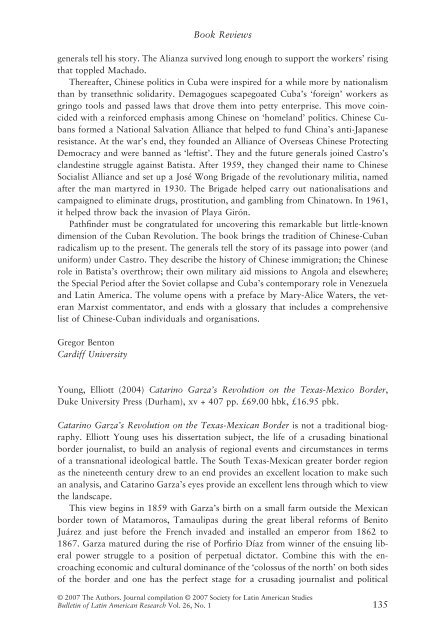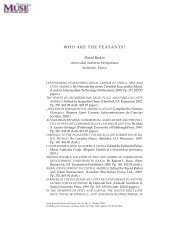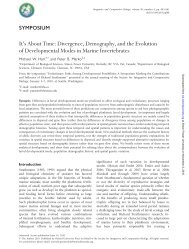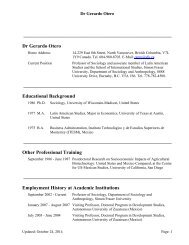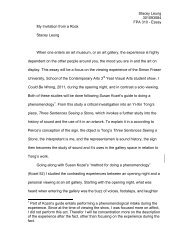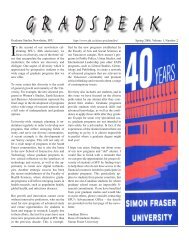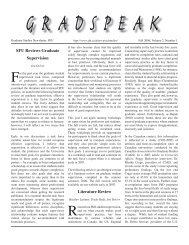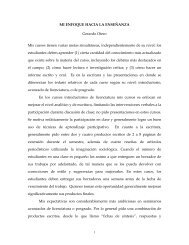Review of Mexico in Transition by Byron Crites
Review of Mexico in Transition by Byron Crites
Review of Mexico in Transition by Byron Crites
- TAGS
- transition
- byron
- crites
- cgi.sfu.ca
Create successful ePaper yourself
Turn your PDF publications into a flip-book with our unique Google optimized e-Paper software.
Book <strong>Review</strong>s<br />
generals tell his story. The Alianza survived long enough to support the workers ’ ris<strong>in</strong>g<br />
that toppled Machado.<br />
Thereafter, Ch<strong>in</strong>ese politics <strong>in</strong> Cuba were <strong>in</strong>spired for a while more <strong>by</strong> nationalism<br />
than <strong>by</strong> transethnic solidarity. Demagogues scapegoated Cuba ’ s ‘ foreign ’ workers as<br />
gr<strong>in</strong>go tools and passed laws that drove them <strong>in</strong>to petty enterprise. This move co<strong>in</strong>cided<br />
with a re<strong>in</strong>forced emphasis among Ch<strong>in</strong>ese on ‘ homeland ’ politics. Ch<strong>in</strong>ese Cubans<br />
formed a National Salvation Alliance that helped to fund Ch<strong>in</strong>a ’ s anti-Japanese<br />
resistance. At the war ’ s end, they founded an Alliance <strong>of</strong> Overseas Ch<strong>in</strong>ese Protect<strong>in</strong>g<br />
Democracy and were banned as ‘ leftist ’ . They and the future generals jo<strong>in</strong>ed Castro ’ s<br />
clandest<strong>in</strong>e struggle aga<strong>in</strong>st Batista. After 1959, they changed their name to Ch<strong>in</strong>ese<br />
Socialist Alliance and set up a José Wong Brigade <strong>of</strong> the revolutionary militia, named<br />
after the man martyred <strong>in</strong> 1930. The Brigade helped carry out nationalisations and<br />
campaigned to elim<strong>in</strong>ate drugs, prostitution, and gambl<strong>in</strong>g from Ch<strong>in</strong>atown. In 1961,<br />
it helped throw back the <strong>in</strong>vasion <strong>of</strong> Playa Girón.<br />
Pathfi nder must be congratulated for uncover<strong>in</strong>g this remarkable but little-known<br />
dimension <strong>of</strong> the Cuban Revolution. The book br<strong>in</strong>gs the tradition <strong>of</strong> Ch<strong>in</strong>ese-Cuban<br />
radicalism up to the present. The generals tell the story <strong>of</strong> its passage <strong>in</strong>to power (and<br />
uniform) under Castro. They describe the history <strong>of</strong> Ch<strong>in</strong>ese immigration; the Ch<strong>in</strong>ese<br />
role <strong>in</strong> Batista ’ s overthrow; their own military aid missions to Angola and elsewhere;<br />
the Special Period after the Soviet collapse and Cuba ’ s contemporary role <strong>in</strong> Venezuela<br />
and Lat<strong>in</strong> America. The volume opens with a preface <strong>by</strong> Mary-Alice Waters, the veteran<br />
Marxist commentator, and ends with a glossary that <strong>in</strong>cludes a comprehensive<br />
list <strong>of</strong> Ch<strong>in</strong>ese-Cuban <strong>in</strong>dividuals and organisations.<br />
Gregor Benton<br />
Cardiff University<br />
Young, Elliott (2004) Catar<strong>in</strong>o Garza ’ s Revolution on the Texas-<strong>Mexico</strong> Border ,<br />
Duke University Press (Durham), xv + 407 pp. £69.00 hbk, £16.95 pbk.<br />
Catar<strong>in</strong>o Garza ’ s Revolution on the Texas-Mexican Border is not a traditional biography.<br />
Elliott Young uses his dissertation subject, the life <strong>of</strong> a crusad<strong>in</strong>g b<strong>in</strong>ational<br />
border journalist, to build an analysis <strong>of</strong> regional events and circumstances <strong>in</strong> terms<br />
<strong>of</strong> a transnational ideological battle. The South Texas-Mexican greater border region<br />
as the n<strong>in</strong>eteenth century drew to an end provides an excellent location to make such<br />
an analysis, and Catar<strong>in</strong>o Garza ’ s eyes provide an excellent lens through which to view<br />
the landscape.<br />
This view beg<strong>in</strong>s <strong>in</strong> 1859 with Garza ’ s birth on a small farm outside the Mexican<br />
border town <strong>of</strong> Matamoros, Tamaulipas dur<strong>in</strong>g the great liberal reforms <strong>of</strong> Benito<br />
Juárez and just before the French <strong>in</strong>vaded and <strong>in</strong>stalled an emperor from 1862 to<br />
1867. Garza matured dur<strong>in</strong>g the rise <strong>of</strong> Porfi rio Díaz from w<strong>in</strong>ner <strong>of</strong> the ensu<strong>in</strong>g liberal<br />
power struggle to a position <strong>of</strong> perpetual dictator. Comb<strong>in</strong>e this with the encroach<strong>in</strong>g<br />
economic and cultural dom<strong>in</strong>ance <strong>of</strong> the ‘ colossus <strong>of</strong> the north ’ on both sides<br />
<strong>of</strong> the border and one has the perfect stage for a crusad<strong>in</strong>g journalist and political<br />
© 2007 The Authors. Journal compilation © 2007 Society for Lat<strong>in</strong> American Studies<br />
Bullet<strong>in</strong> <strong>of</strong> Lat<strong>in</strong> American Research Vol. 26, No. 1 135


